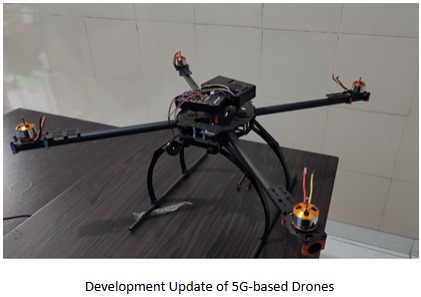xG Research Center Releases Interim Findings on 5G-Powered Drone Inspections: Unlocking New Levels of Efficiency and Safety with Advanced Network Capabilities
Bandung, Indonesia – June 19th, 2023 – The xG Research Center of Use Cases and Applications (“xG Research Center”) today announced promising interim results from its ongoing research into 5G-powered drone inspection solutions. The findings highlight the transformative potential of 5G technology to enhance drone capabilities and revolutionize inspection processes across various industries.
5G: The Key to Unlocking Drone Potential
The research confirms that 5G networks provide significant advantages for drone operations, enabling unprecedented levels of efficiency, safety, and versatility. Key findings include:
- Blazing Fast Speeds: 5G delivers peak data rates of up to 20 Gbps, enabling drones to transmit multiple high-definition video streams and sensor data in real-time. Imagine a drone equipped with a 4K camera seamlessly streaming live video while simultaneously transmitting other sensor readings – all thanks to 5G’s incredible bandwidth. This capability is crucial for applications like infrastructure inspection, where detailed visual information is essential for identifying potential issues.
- Ultra-Responsive Control: With latencies as low as 1 millisecond, 5G ensures near-instantaneous communication between drones and ground control. This lightning-fast responsiveness is critical for real-time drone control, especially in applications like emergency response where every second counts.
- Extended Reach: 5G networks provide broader coverage than previous generations, extending the operational range of drones and enabling them to reach further into rural areas and urban environments. Advanced technologies like beamforming allow 5G base stations to focus signals directly towards a drone, maintaining a strong connection even at a distance of several kilometers. This opens up new possibilities for drone applications in remote areas and beyond visual line of sight (BVLOS) operations.
- Customized Networks: Network slicing allows for the creation of dedicated virtual networks within the 5G infrastructure, tailored to the unique needs of different drone use cases. This ensures optimal performance and resource allocation for diverse drone operations, from delivery and logistics to infrastructure inspection and public safety. For instance, a dedicated network slice with ultra-low latency can be created for emergency response drones, while another slice with high bandwidth can support drones used for aerial surveillance and data collection.
- Enhanced Security: 5G incorporates robust security protocols and advanced encryption algorithms, such as 256-bit encryption, to safeguard drone communications and prevent unauthorized access to sensitive data. This is crucial for maintaining the integrity and confidentiality of drone operations, particularly in critical infrastructure and public safety applications.
Transforming Industries with 5G-Powered Drones
These findings demonstrate the potential of 5G-powered drones to transform various industries by:
- Improving safety: Enabling remote inspections of hazardous or difficult-to-reach areas, minimizing risks to human workers.
- Increasing efficiency: Automating inspection tasks, reducing manpower requirements, and accelerating data collection and analysis.
- Enhancing accuracy: Providing real-time data and high-resolution imagery for more precise and informed decision-making.
- Reducing costs: Optimizing inspection workflows and minimizing downtime, leading to significant cost savings.
About the xG Research Center
The xG Research Center is a leading research facility dedicated to exploring the vast potential of current and future mobile network technologies. Established through a dynamic partnership between the School of Engineering and Informatics at Bandung Institute of Technology (ITB) and PT Huawei Tech Investment, the Center focuses on developing innovative use cases and applications for 5G and beyond (xG), fostering collaboration between academia and industry to drive the advancement of mobile technology and its positive impact on society.

